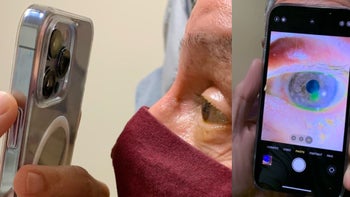
At the very end of September, a story broke out about an ophthalmologist (eye doctor) using the iPhone 13 Pro Max macro feature to make detailed observations of his patient’s eyes. The doctor’s name is Tommy Korn, and since that story became viral, he has faced a lot of criticism.
In an interview with Petapixel, Dr. Tommy Korn goes on to explain his approach and intentions in more detail, having noticed that there is some confusion about his story.
Dr. Korn says that the main purpose of the iPhone is to easily document the condition of his patient. He notes that the phone is simply used as a means of taking notes to refer back to the next time the patient comes.
Let’s say you have an eye condition or eye problem and you have to see a doctor and you see them six months later and you ask ‘hey, how does it look compared to last time.’ Do you think the doctor remembers? They can’t remember. They look at notes and verbal descriptions.
Why not use a professional camera?
Some have suggested that the doctor should use professional DSLR cameras instead, because they can produce higher-quality images, which allow for closer examination. However, Korn’s answer to that is ‘I’m using it for documentation. I have just enough information to know if it’s serious or not.’That is not to say, though, that the ophthalmologist has never used any other equipment to achieve his goal. In fact, in the past, he used an expensive DSLR camera with a macro lens. He also used a professional slit-eye camera in combination with an iPhone 6 plus.
Alas, he claims that both these approaches had too many ‘friction points,’ meaning there were steps in the process that slowed it down or made it inconvenient for the workflow.
‘This is a pro camera that comes with a computer attached to it. So, that being said, I use this camera to document patient photos and attach them to my records with a few taps,’ says Dr. Korn.
What’s more, he also says that AirDrop also comes in useful as he can instantly send the photos for his patients to have them as well. The photos can prove especially helpful if the patient has to go to a different expert somewhere else. Of course, this is achievable whether you have an iPhone or not, with lots of other file transfer options out there.
The other point that the doctor makes is that the iPhone 13 Pro line is a great new tool for telemedicine since it is accessible and easy to use at home. That way, he says, patients can ‘still get care conveniently at home.’

